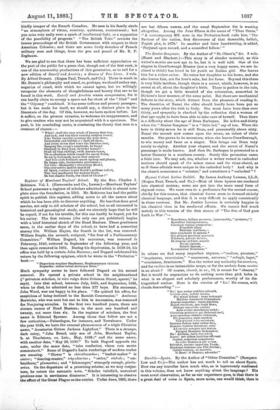Register of Merchant Taylors' School. By the Rev. Charles J.
Robinson. Vol. I. (Farncombe and Co., Lewes.)—Merchant Taylors' School possesses a register of scholars admitted which is almost com- plete since the foundation, in 1561. Mr. Robinson has had the public spirit to publish this register, adding notes to all the names about which he has been able to discover anything. He has thus done good service, not only to old scholars of the school, but to all interested in historical and genealogical study, and we sincerely hope that he will be repaid, if not for his trouble, for this can hardly be hoped, yet for his outlay. The first volume (the only one yet published) begins with a brief historical sketch of the Head Masters. These gentlemen seem, in the earlier days of the school, to have had a somewhat stormy life. William Rayne, the fourth in the list, was removed. William Staple, the seventh, resigned, "for fear of a Parliamentary Committee." William Dagard, his successor, was removed in February, 1649, restored in September of the following year, and then again removed in 1661. During his deprivation, in 1649.50, his office was held by a certain John Stevens ; and Dugard celebrated his return by the following epigram, which he wrote in the "Probation" book :— "Dngardum sequitur Stephanus, Btephanumque vicissim Dagardus: sortesversat utriusque Dens."
Much sympathy seems to have followed Dngard on his second removal. He opened a private school in the neighbourhood (" privatam soholam, in vico vulgo dicto Coleman Street, aperai," he says). Into that school, between July, 1661, and September, 1662, when be died, he admitted no less than 277 boys. His successor, John Wood, was not happy in his place. " He quitted his office, for suspicions of being inclined to the Romieh Communion." Ambrose Berwicke, who was next but one to him in succession, was removed for Nonjaring scruples. In the first two hundred years, there are sixteen names of Head Masters ; in the next one hundred and twenty, not more than six. In the register of scholars, the first name is Edmund Spenser. Among those that follow are not a few curiosities,—Palaeologas, for instance, and Terrabosco. Under the year 1648, we have the unusual phenomenon of a triple Christian name, " Anastasins Cotton Jackson Lightfoot." There is a strange, dark entry, "John Brand, only son of John, Merchant Taylor, b. at Thurlstone, co. Leic., May, 1638 ;" and the same name, with another date, " May 29, 1639." To both Bogard appends the note, under the same date, " tabe confectus, vitam cum morte commutavit." Some of Dugard's Latin renderings of modern trades are amusing. " Glover " is chirothecarius ; " basket-maker " is victor; " dancing-master," tripudiarius ; " ostler," stabulo ; "em- broiderer," plumarius; and " fishmonger," strangely enough, piscin- arius. On the departure of a promising scholar, as we may conjec- ture, he enters the sarcastic note, " Scholae valedixit, mercatori protinus sere in servitutem dicaturns." It is interesting to observe the effect of the Great Plague on the entries. Under June, 1605; there
are but fifteen names, and the usual September list is wanting altogether. Among the June fifteen is the name of "Titus Oates." " A contemporary MS. note in the Probation-book calls him, The Saviour of the nation, first discoverer of that damnable, hellish, Popish plot, in 1678: In another and later handwriting, is added, `Perjured upon record, and a scoundrel fellow.' "


































 Previous page
Previous page